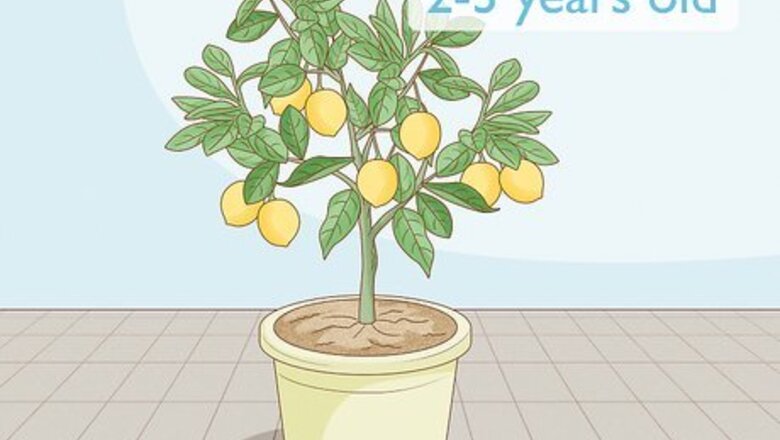
views
X
Research source
Planting the Tree
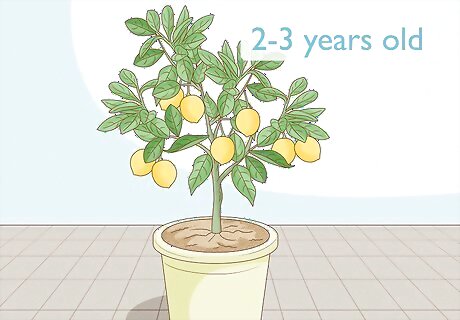
Pick Meyer lemon trees for growing indoors. Meyer lemon trees are the best and most adaptable tree for growing inside. They produce plenty of small or medium fruits and their maintenance level is more friendly for beginners. Pink variegated lemon trees also grow well indoors and are beginner-friendly. Buy a lemon tree at least 2-3 years old, as young trees may not grow as well indoors. Although you can grow lemon trees from seed, they are less likely to adapt to indoor climates and will not produce the same as their parent tree.
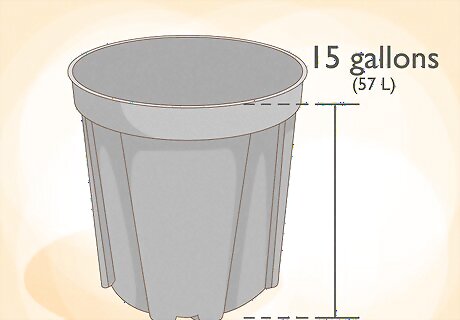
Choose a deep plastic pot for your lemon plant. Plastic pots are ideal for lemon trees so you can move the plant around as the seasons (and light sources) change. Look for a plastic pot with plenty of depth to help your tree balance as it gets larger and produces fruits. The pot depth determines how large the lemon plant can grow. About 15 gallons (57 L) is the minimum recommended pot size. Choose a pot that has drainage holes to prevent your plant from getting waterlogged.
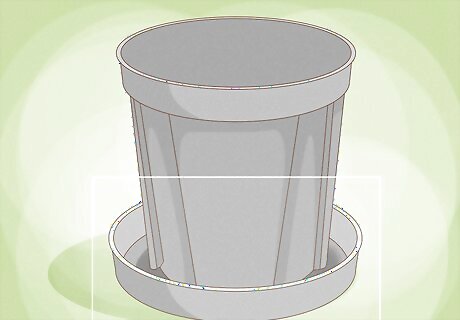
Find a saucer large enough to fit beneath the container. Place a few pebbles or gravel on the saucer and add a little water before placing the container on the saucer and the pebbles. The water-filled saucer will help maintain a trace amount of humidity around your tree. You can cut a strip of landscaper's cloth and place it at the bottom of the pot to keep it from leaking dirt into the saucer. Replace the cloth when you transplant the tree so you don’t clog the hole.

Buy a slightly acidic potting mix for your tree. Lemon trees grow well in peat moss mix because it is mildly acidic and well-draining. Buy it or another acidic, well-draining soil mix from a nearby garden center or plant nursery. Soils meant for cacti will also work well for citrus trees.
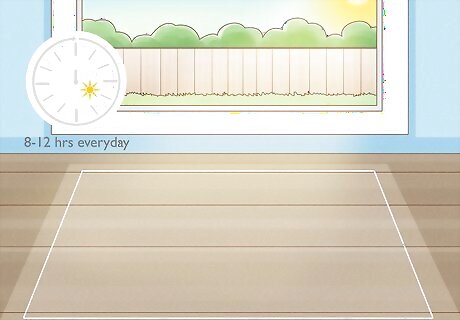
Find a sunny spot for your lemon tree to grow. Lemon trees grow best when they have at least 8-12 hours of direct sunlight. Choose a spot by a window where your plant will get direct sunlight all day. If you're in a location that doesn't get a lot of sun, set up a grow light near the plant and leave it on for up to 12 hours a day.

Take the lemon tree out of its nursery pot and spread its roots. Massage the roots with your fingers, gently pulling them apart with your hands. This will help its roots spread faster get more nutrients and water from the soil. Pull carefully to avoid damaging or breaking off the roots.
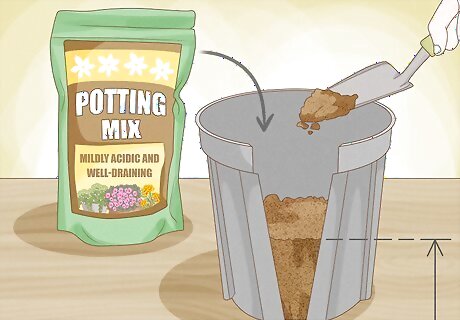
Fill the pot halfway with soil mix. Before planting your lemon tree, add about 1/2 of the soil mix to your pot and smooth it over until even. This will help your lemon tree's roots grow into the soil and help it stay upright as you place it in.
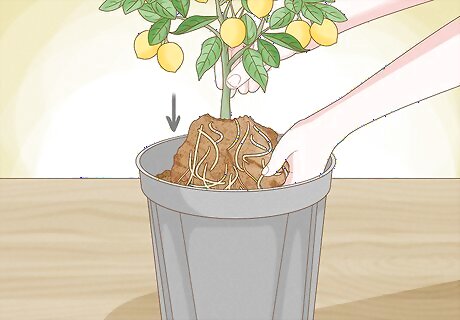
Place the lemon tree in the pot. Position it upright in the pot and fill the rest of the pot with soil. Press the soil around the plant's base down, making sure that no roots are left exposed and out of the soil. Bury the tree at the same level as it was in the older pot. Avoid covering the trunk with soil, as this can cause fungal infections.

Water your tree immediately after planting it. Moistening the soil will help make it more habitable for your plant as it adapts. Water the tree until the soil is damp, but not soaked or waterlogged.
Caring for Lemon Trees
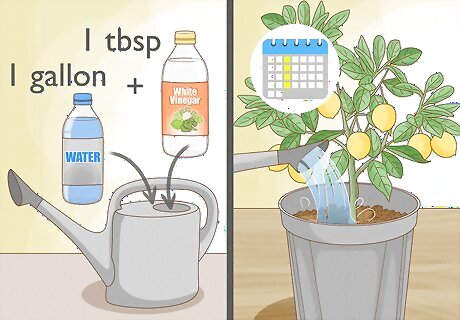
Water your lemon tree weekly. If your lemon tree doesn't get enough water, the natural salts that it produces may accumulate in the soil. Keep the soil moist, but not waterlogged to prevent root rot. If using hard tap water, you may need to drop the water's pH before giving it to your tree. Adding 1 tablespoon (15 milliliters) white vinegar to 1 gallon (4 liters) of water will usually do the trick. If your tree’s leaves are curling, your tree needs more water. EXPERT TIP Mark Leahy Mark Leahy Plant Specialist Mark Leahy is a Plant Specialist based in the San Francisco Bay Area. He is the Co-Owner of Bella Fiora, a custom design floral studio, and SF Plants, a plant shop and nursery. Mark specializes in floral artistry and indoor plants including floral arrangements, terrace planters, office plantscapes, and living walls. Mark and his business partner have been featured in Vogue, The Knot, Today’s Bride, Wedding Wire, Modern Luxury, San Francisco Bride Magazine, San Francisco Fall Antique Show, Black Bride, Best of the Bay Area A-List, and Borrowed & Blue. Mark Leahy Mark Leahy Plant Specialist Since lemon trees need a lot of sunlight, they tend to dry out quickly. Check your lemon tree regularly—once it's dried out 2 inches below the soil, water it.
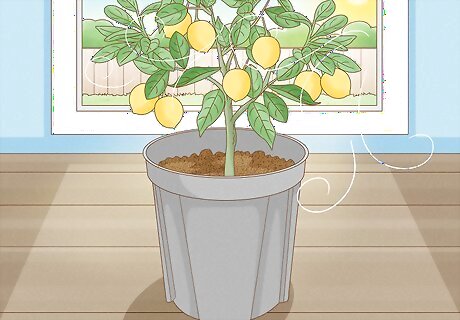
Keep the air around your plant circulated. To imitate outdoor conditions, open a door or window near your plant in warm weather. If the air is too cold, set up a rotating fan near the lemon tree to help the air stay well-ventilated.

Fertilize your plant once every few months. Lemon trees grow well if they get plenty of nitrogen—you can find nitrogen-rich fertilizers at most plant stores. Feed your plant once every 3 weeks in spring or summer and once every 6 weeks in fall and winter. An NPK fertilizer of 2-1-1 works well for citrus trees. Do not use fertilizers containing alfalfa meal or cottonseed meal. Fertilizers containing these meals can cause fungal diseases.
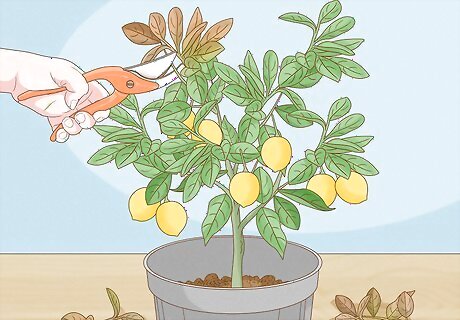
Perform only mild pruning on your tree. Pruning too many leaves will reduce your yield, but occasional pruning can be helpful. Remove dead, broken, and diseased branches, and thin to control the height and spread of your tree as space allows. Lemon trees can be pruned year-round when grown indoors.

Set up a humidifier near your lemon plant. Lemon trees naturally grow in humid climates. Placing a humidifier near the tree can keep the air from getting stale. Set the humidifier to at least 50% to give your plant enough moisture in the air. Misting your lemon tree with water several times a week or when it rains can also restore the plant's humidity levels. If you live in a humid location, you may be able to get enough humidity from opening a door or window.
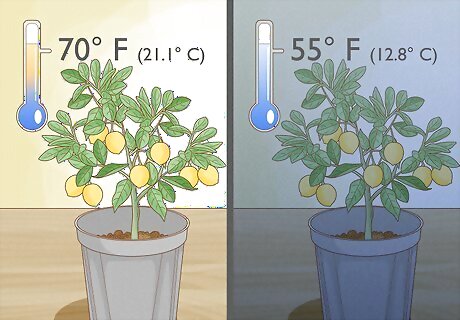
Manage the temperature of your room to ensure a healthy harvest. These trees do best in rooms with an average temperature of 70 degrees Fahrenheit (21.1 degrees Celsius) by day and 55 degrees Fahrenheit (12.8 degrees Celsius) at night. While temperatures that dip below 55 degrees Fahrenheit (12.8 degrees Celsius) will not kill your tree, they will cause your tree to go into dormancy and stop growing.
Harvesting Lemons

Pollinate your lemon tree with a paintbrush. Because your tree won't have insects to spread its pollen around, you'll need to pollinate the plant manually for it to grow fruit. Rub the paintbrush against the plant's stamen and anthers, the pollen-covered buds around the middle of the plant's flowers. Transfer the pollen to the pistil, the bulb located deep in the center of the flower. Repeat this process once a day to ensure pollination. Most lemon trees take 6-9 months to harvest after being successfully pollinated. Your lemon tree may produce fruit even if you don't pollinate it, but the fruit will be larger if it is pollinated.
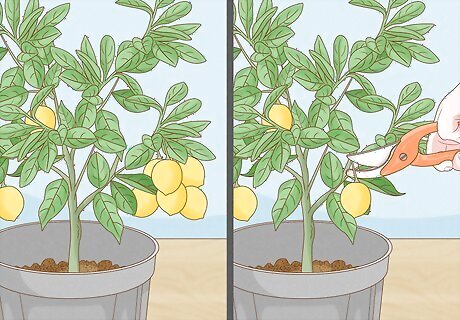
Thin out any heavy lemon clusters that grow. Once a cluster of small lemons appears on your tree, remove 2/3 of them to allow the remaining 1/3 a chance to grow large. Snip away the extra lemons with pruning shears, cutting carefully at the stalk. Too many lemon clusters can drain your tree of energy and stunt all of the fruits' growth. Many trees will drop fruit on their own. Wait a few months before removing any fruit.

Test the fruits for ripeness with your thumb. As your lemons grow, apply pressure with your thumb to the rind. If the inside feels soft and plump instead of hard, the plant is ready for you to harvest. The fruits can be left on the tree for awhile without becoming overripe. The fruits will usually stop growing once they're ready to harvest. They should also be a rich yellow color.
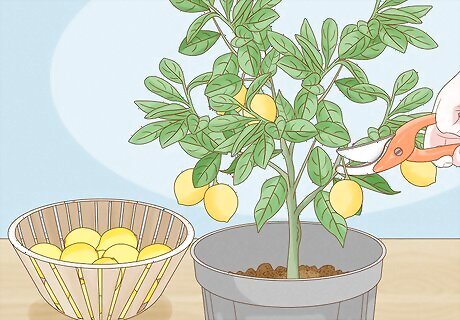
Cut your lemons from the tree with pruning shears. Take the pruning shears and clip them off of the tree at the fruit stalk. If you don't have pruning shears, you can also carefully pull the lemon from the tree. Pull or cut gently to prevent damaging your plant.
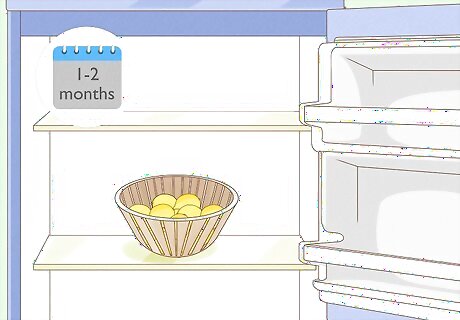
Store your lemons for 1-2 months on your kitchen counter or in your fridge. After harvesting your lemons, you can store them for 2-4 weeks on a counter and 1-2 months in a refrigerator. Avoid cutting your lemons until you're ready to use them, as cut lemons only last for 2-3 days in a fridge. If you want to store your lemons for longer, squeeze the juice and store it in an airtight container for 4-6 months in a fridge or freezer.
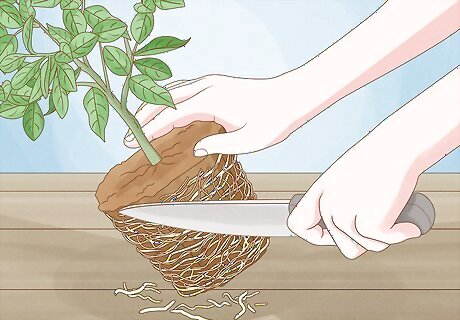
Prune your plant's roots if it stops producing lemons. Your tree should remain root-bound in order to keep its size in check, but some potted lemon trees will stop producing fruit if their roots get too pot bound. Remove your tree from its pot and use a sharp knife to shave 1/2-inch to 1-inch (1.27 to 2.5 centimeters) of the roots around the exterior of the root ball. Keep the roots moist while you walk by spritzing them with water from a spray bottle. Repot the tree and prune approximately 1/3 of its foliage to balance out the pruned roots.




















Comments
0 comment